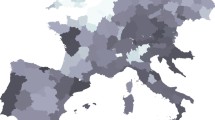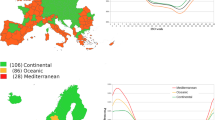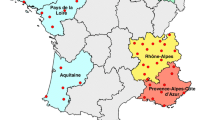Abstract
The reasons for the seasonality and annual changes in the impact of influenza epidemics remain poorly understood. We investigated the covariations between a major component of climate, namely the El Niño Southern Oscillation (ENSO), and indicators of the impact of influenza, as measured by morbidity, excess mortality and viral subtypes collected in France during the period 1971–2002. We show that both the circulating subtype and the magnitude of ENSO are associated with the impact of influenza epidemics. Recognition of this association could lead to better understanding of the mechanisms of emergence of influenza epidemics.
Similar content being viewed by others
References
Dobson R. Flu rates in Wales highest for a decade. Br Med J 2000; 320: 138.
Christie B. Scotland facing worst flu outbreak for six years. Br Med J 2000; 320: 138.
Woodman R. Doctors and politicians clash over size of flu problem. Br Med J 2000; 320: 138.
Monto AS. Individual and community impact of influenza. Pharmacoeconomics 1999; 16: 1–6
Cox NJ, Subbarao K. Influenza. Lancet 1999; 354: 1277–1282.
Simonsen L, Clarke MJ, Williamson GD, Stroup DF, Arden NH, Schonberger LB. The impact of influenza epidemics on mortality: introducing a severity index. Am J Public Health 1997; 87: 1944–1950.
Carrat F, Valleron AJ. Influenza mortality among the elderly in France, 1980–90: How many deaths may have been avoided through vaccination? J Epidemiol Commun Health 1995; 49: 419–425.
Fleming DM, Zambon M, Bartelds AI, de Jong JC. The duration and magnitude of influenza epidemics: A study of surveillance data from sentinel general practices in England, Wales and The Netherlands. Eur J Epidemiol 1999; 15: 467–473.
Carrat F, Sahler C, Rogez S, et al. Influenza burden-of-illness: Estimates from a national prospective survey of household contacts in France. Arch Intern Med 2002; 162: 1842–1848.
Cox NJ, Subbarao K. Global epidemiology of influenza: Past and present. Annu Rev Med 2000; 51: 407–421.
Thacker SB. The persistence of influenza A in human populations. Epidemiol Rev 1986; 8: 129–142.
Hope-Simpson RE. The role of season in the epidemiology of influenza. J Hyg (Lond) 1981; 86: 35–47.
Glantz MH. Currents of Change: Impacts of El Ninõ and La Ninã on Climate and Society, 2nd edn. Cambridge University Press, 2001.
Ebi KL, Exuzides KA, Lau E, Kelsh M, Barnston A. Association of normal weather periods and El Nino events with hospitalization for viral pneumonia in females: California, 1983–1998. Am J Public Health 2001; 91: 1200–1208.
Colwell RR, Patz JA. Climate, Infectious Disease and Health: An Interdisciplinary Perspective. Washington DC: American Academy of Microbiology, 1998.
Wang HJ, Zhang RH, Cole J, Chavez F. El Nino and the related phenomenon Southern Oscillation (ENSO): The largest signal in interannual climate variation. Proc Natl Acad Sci USA 1999; 96: 11071–11072.
Epstein PR, Calix Pena O, Blanco Racedo J. Climate and disease in Colombia. Lancet 1995; 346: 1243–1244.
Epstein PR. Global warming and vector-borne disease. Lancet 1998; 351: 1737; discussion 1738.
Bouma MJ, Sondorp HE, van der Kaay HJ. Health and climate change. Lancet 1994; 343: 302.
Bouma MJ, Kovats RS, Goubet SA, Cox JS, Haines A. Global assessment of El Nino's disaster burden. Lancet 1997; 350: 1435–1438.
Patz JA, Epstein PR, Burke TA, Balbus JM. Global climate change and emerging infectious diseases. JAMA 1996; 275: 217–223.
Hales S, Weinstein P, Woodward A. Dengue fever epidemics in the South Pacific: Driven by El Nino Southern Oscillation? Lancet 1996; 348: 1664–1665.
Hales S, Weinstein P, Souares Y, Woodward A. El Nino and the dynamics of vectorborne disease transmission. Environ Health Perspect 1999; 107: 99–102.
Linthicum KJ, Anyamba A, Tucker CJ, Kelley PW, Myers MF, Peters CJ. Climate and satellite indicators to forecast Rift Valley fever epidemics in Kenya. Science 1999; 285: 397–400.
Bouma MJ, van der Kaay HJ. Epidemic malaria in India and the El Nino southern oscillation. Lancet 1994; 344: 1638–1639.
Bouma MJ, Sondorp HE and van der Kaay HJ. Climate change and periodic epidemic malaria. Lancet 1994; 343: 1440.
Bouma MJ, Dye C, van der Kaay HJ. Falciparum ma-laria and climate change in the northwest frontier prov-ince of Pakistan. AmJ Trop Med Hyg 1996; 55: 131–137.
Bouma MJ, Dye C. Cycles of malaria associated with El Ninõ in Venezuela. JAMA 1997; 278: 1772–1774.
Colwell RR. Global climate and infectious disease: The cholera paradigm. Science 1996; 274: 2025–2031.
Lobitz B, Beck L, Huq A, et al. From the cover: climate and infectious disease: Use of remote sensing for detection of Vibrio cholerae by indirect measurement. Proc Natl Acad Sci USA 2000; 97: 1438–1443.
Pascual M, Rodo X, Ellner SP, Colwell R, Bouma MJ. Cholera dynamics and El Nino-Southern Oscillation. Science 2000; 289: 1766–1769.
Checkley W, Epstein LD, Gilman RH, et al. Effects of el Ninõ and ambient temperature on hospital admis-sions for diarrhoeal diseases in Peruvian children. Lancet 2000; 355: 442–450.
Hay SI, Myers MF, Burke DS, et al. Etiology of inte-repidemic periods of mosquito-borne disease. Proc Natl Acad Sci USA 2000; 97: 9335–9339.
Garnerin P, Saidi Y, Valleron AJ. The French Com-municable Diseases Computer Network. A seven-year experiment. Ann N Y Acad Sci 1992; 670: 29–42.
Colin C, Geffroy L, Maisonneuve H, et al. Country profile. France. Lancet 1997; 349: 791–797.
Costagliola D, Flahault A, Galinec D, Garnerin P, Menares J, Valleron AJ. A routine tool for detection and assessment of epidemics of influenza-like syn-dromes in France. Am J Pub Health 1991; 81: 97–99.
Kulperger RA, Lockhart J. Tests of Independence in Time Series. J Time Ser Anal 1998; 19: 165.
Efron B, Tibshirani RJ. Introduction to the Bootstrap. Monograph on Statistics and Applied Probability. New York: CRC Press, 1993.
Shortridge KF. Is China an influenza epicentre? Chin Med J (Engl) 1997; 110: 637–641.
Hammond GW, Raddatz RL, Gelskey DE. Impact of atmospheric dispersion and transport of viral aerosols on the epidemiology of influenza. Rev Infect Dis 1989; 11: 494–497.
Author information
Authors and Affiliations
Rights and permissions
About this article
Cite this article
Viboud, C., Pakdaman, K., Boëlle, Py. et al. Association of influenza epidemics with global climate variability. Eur J Epidemiol 19, 1055–1059 (2004). https://doi.org/10.1007/s10654-004-2450-9
Issue Date:
DOI: https://doi.org/10.1007/s10654-004-2450-9




